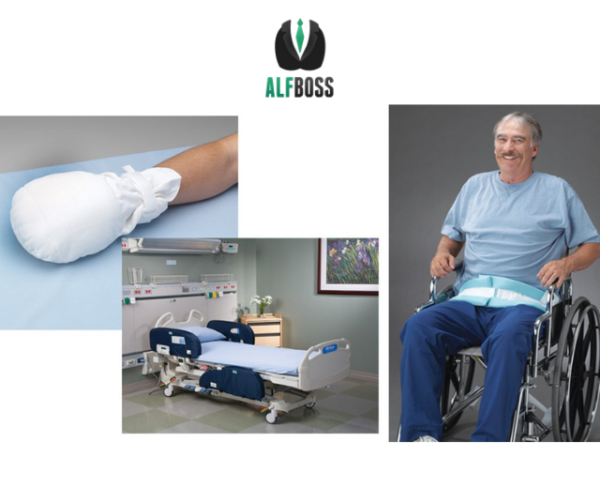
The use of restraints in seniors brings about questions of ethical morality due to the application of restraints decreasing the autonomy and overall wellbeing of the person. This is especially true in the assisted living setting as it directly contradicts the goal of providing an independent environment for residents. With that said, there may be situations where the use of physical restraints may be required for the benefit of the resident. For more information on how to be in compliance when applying a restraint check out the regulation below:
22VAC40-73-710. Restraints.
- The use of chemical restraints is prohibited. The use of prone or supine restraints is prohibited. The use of any restraint or restraint technique that restricts a resident’s breathing, interferes with a resident’s ability to communicate, or applies pressure on a resident’s torso is prohibited.
- Physical restraints shall not be used for purposes of discipline or convenience. Physical restraints may only be used (i) as a medical/orthopedic restraint for support, according to a physician’s written order and with the written consent of the resident or his legal representative or (ii) in an emergency situation after less intrusive interventions have proven insufficient to prevent the imminent threat of death or serious physical injury to the resident or others.
- If a restraint is used, it must:
- Be imposed in accordance with a physician’s written order that specifies the condition, circumstances, and duration under which the restraint is to be used; and
- Not be ordered on a standing, blanket, or “as needed” (PRN) basis.
- Whenever physical restraints are used, the following conditions shall be met:
- Restraint shall be used only to the minimum extent necessary to protect the resident or others;
- Restraints shall only be applied by direct care staff who have received training in their use as specified by subdivision 2 of 22VAC40-73-270;
- The facility shall closely monitor the condition of a resident with a restraint, which includes checking on the resident at least every 30 minutes;
- The facility shall assist the resident with restraint as often as necessary, but no less than 10 minutes every hour, for his hydration, safety, comfort, range of motion, exercise, elimination, and other needs;
- The facility shall release the resident from the restraint as quickly as possible; and
- Direct care staff shall keep a record of restraint usage, outcomes, checks, and any assistance required in subdivision 4 of this subsection and shall note any unusual occurrences or problems.
- When restraints are used in nonemergencies, as defined in 22VAC40-73-10, the following conditions shall be met:
- Restraints shall be used as a last resort and only if the facility, after completing, implementing, and evaluating the resident’s comprehensive assessment and service plan, determines and documents that less restrictive means have failed;
- Physician orders for medical/orthopedic restraints must be reviewed by the physician at least every three months and renewed if the circumstances warranting the use of the restraint continue to exist;
- Restraints shall be used in accordance with the resident’s service plan, which documents the need for the restraint and includes a schedule or plan of rehabilitation training enabling the progressive removal or the progressive use of less restrictive restraints when appropriate;
- Before the initial administration of restraint, the facility shall explain the use of the restraint and potential negative outcomes to the resident or his legal representative and the resident’s right to refuse the restraint and shall obtain the written consent of the resident or his legal representative;
- Restraints shall be applied so as to cause no physical injury and the least possible discomfort; and 6. The facility shall notify the resident’s legal representative or designated contact person as soon as practicable, but no later than 24 hours after the initial administration of a non-emergency restraint. The facility shall keep the resident and his legal representative or designated contact person informed about any changes in restraint usage. A notation shall be made in the resident’s record of such notice, including the date, time, a person notified method of notification, and staff providing notification.
- When restraints are used in emergencies, as defined in 22VAC40-73-10 the following conditions shall be met:
- Restraints may only be used as an emergency intervention of last resort to prevent the imminent threat of death or serious physical injury to the resident or others;
- An oral or written order shall be obtained from a physician within one hour of administration of the emergency restraint and the order shall be documented;
- In the case of an oral order, a written order shall be obtained from the physician as soon as possible;
- The resident shall be within sight and sound of direct care staff at all times;
- If the emergency restraint is necessary for longer than two hours, the resident shall be transferred to a medical or psychiatric inpatient facility or monitored in the facility by a mental health crisis team until his condition has stabilized to the point that the attending physician documents that restraints are not necessary;
- The facility shall notify the resident’s legal representative or designated contact person as soon as practicable, but no later than 12 hours after administration of an emergency restraint. A notation shall be made in the resident’s record of such notice, including the date, time, caller and person notified; and
- The facility shall review the resident’s individualized service plan within one week of the application of an emergency restraint and document additional interventions to prevent the future use of emergency restraints.